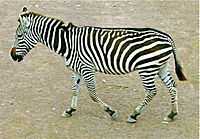Quadrupedalism

Quadrupedalism is a form of terrestrial locomotion in animals using four limbs or legs. An animal or machine that usually moves in a quadrupedal manner is known as a quadruped, meaning "four feet" (from the Latin quad for "four" and ped for "foot"). The majority of quadrupeds are vertebrate animals, including mammals such as cattle, dogs and cats, and reptiles, like lizards.
Birds, humans, insects, crustaceans, and snakes are usually not quadrupeds, with some exceptions; for example, among the insects, the praying mantis is a quadruped. A few birds may use quadrupedal movement in some circumstances; for example, the shoebill will sometimes use its wings to right itself after lunging at prey.[1]
Quadrupeds vs. tetrapods
Not all four-limbed animals are quadrupeds. Although arms and wings are, in the evolutionary sense, modified legs, four-limbed vertebrates are in fact classed as tetrapods, members of the taxonomic unit Tetrapoda. These include all vertebrates with quadrupedal ancestors, including mammals, reptiles, amphibians, and birds.
The distinction between quadrupeds and tetrapods is important in evolutionary biology, particularly in the context of bipeds, winged animals, and animals whose limbs have adapted to other roles (e.g. fins, in the case of cetaceans and pinnipeds). All of these animals are tetrapods, but none is a quadruped. Even snakes, whose limbs have become vestigial or lost entirely, are nevertheless tetrapods.
Quadrupedalism in humans

In July 2005, in rural Turkey, scientists discovered five Kurdish siblings who had learned to walk naturally on their hands and feet. Unlike chimpanzees, who ambulate on their knuckles, the Turkish siblings (ranging from 18 to 34 years old) walked on their palms, allowing them to preserve the dexterity of their fingers. Another similar case has been reported in Chile, but the case is still being investigated and reports are not released as of March 2006.
The discovery of the family has provided scientists a unique view into human evolutionary history. Nicholas Humphrey and John Skoyles from the London School of Economics and Roger Keynes from Cambridge University have suggested that their gait is due to two rare phenomena coming together.[2] First, instead of initially crawling as infants on their knees, they started off learning to move around with a "bear crawl" on their feet. Second, due to their congenital brain impairment, they found balancing on two legs difficult. Because of this, their motor development was channelled into turning their bear crawl into a substitute for bipedality.
Other scientists, such as Stefan Mundlos of the Max Planck Institute, believe that the family's unusual gait may result from a genetic abnormality. Mundlos has found a region on chromosome 17 that might be responsible for human bipedalism.
Quadrupedal movement for exercise
Many people, especially practitioners of Parkour and Freerunning and Georges Hébert's Natural Method, find benefit in using quadrupedal movement in order to build full body strength. For added difficulty this can be done faster or slower, or more exaggerated and to the effect of a push-up, or down stairs. Moving quadrupedally exercises the entire anterior: thighs, core, shoulders, and triceps.
Kenichi Ito is a Japanese man who is famous for speed running on four limbs.
Quadrupedal robots
BigDog is a dynamically stable quadruped robot created in 2005 by Boston Dynamics with Foster-Miller, the NASA Jet Propulsion Laboratory, and the Harvard University Concord Field Station.[3]
See also
References
External links
| |||||||||||||||||||